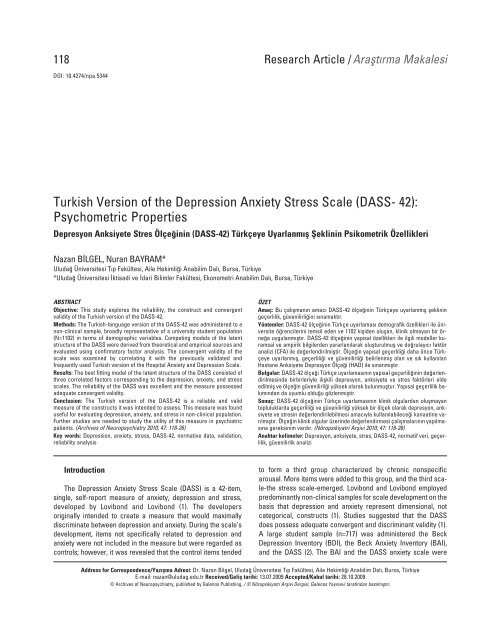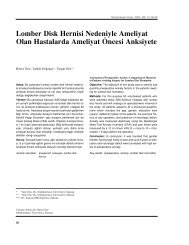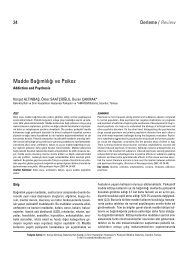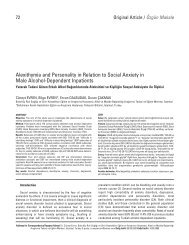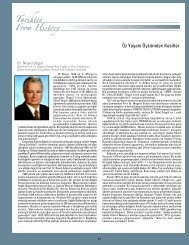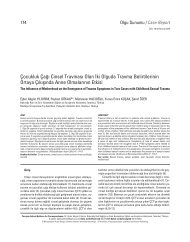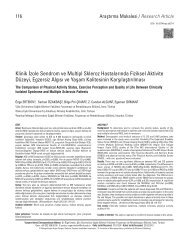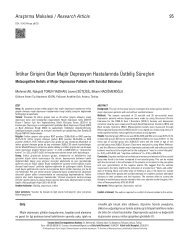Turkish Version of the Depression Anxiety Stress Scale
Turkish Version of the Depression Anxiety Stress Scale
Turkish Version of the Depression Anxiety Stress Scale
You also want an ePaper? Increase the reach of your titles
YUMPU automatically turns print PDFs into web optimized ePapers that Google loves.
118Research Article /Araflt›rma MakalesiDOI: 10.4274/npa.5344<strong>Turkish</strong> <strong>Version</strong> <strong>of</strong> <strong>the</strong> <strong>Depression</strong> <strong>Anxiety</strong> <strong>Stress</strong> <strong>Scale</strong> (DASS- 42):Psychometric PropertiesDepresyon Anksiyete Stres Ölçe¤inin (DASS-42) Türkçeye Uyarlanm›fl fieklinin Psikometrik ÖzellikleriNazan B‹LGEL, Nuran BAYRAM*Uluda¤ Üniversitesi T›p Fakültesi, Aile Hekimli¤i Anabilim Dal›, Bursa, Türkiye*Uluda¤ Üniversitesi ‹ktisadi ve ‹dari Bilimler Fakültesi, Ekonometri Anabilim Dal›, Bursa, TürkiyeABSTRACTObjective: This study explores <strong>the</strong> reliability, <strong>the</strong> construct and convergentvalidity <strong>of</strong> <strong>the</strong> <strong>Turkish</strong> version <strong>of</strong> <strong>the</strong> DASS-42.Methods: The <strong>Turkish</strong>-language version <strong>of</strong> <strong>the</strong> DASS-42 was administered to anon-clinical sample, broadly representative <strong>of</strong> a university student population(N=1102) in terms <strong>of</strong> demographic variables. Competing models <strong>of</strong> <strong>the</strong> latentstructure <strong>of</strong> <strong>the</strong> DASS were derived from <strong>the</strong>oretical and empirical sources andevaluated using confirmatory factor analysis. The convergent validity <strong>of</strong> <strong>the</strong>scale was examined by correlating it with <strong>the</strong> previously validated andfrequently used <strong>Turkish</strong> version <strong>of</strong> <strong>the</strong> Hospital <strong>Anxiety</strong> and <strong>Depression</strong> <strong>Scale</strong>.Results: The best fitting model <strong>of</strong> <strong>the</strong> latent structure <strong>of</strong> <strong>the</strong> DASS consisted <strong>of</strong>three correlated factors corresponding to <strong>the</strong> depression, anxiety, and stressscales. The reliability <strong>of</strong> <strong>the</strong> DASS was excellent and <strong>the</strong> measure possessedadequate convergent validity.Conclusion: The <strong>Turkish</strong> version <strong>of</strong> <strong>the</strong> DASS-42 is a reliable and validmeasure <strong>of</strong> <strong>the</strong> constructs it was intended to assess. This measure was founduseful for evaluating depression, anxiety, and stress in non-clinical population.Fur<strong>the</strong>r studies are needed to study <strong>the</strong> utility <strong>of</strong> this measure in psychiatricpatients. (Archives <strong>of</strong> Neuropsychiatry 2010; 47: 118-26)Key words: <strong>Depression</strong>, anxiety, stress, DASS-42, normative data, validation,reliability analysisÖZETAmaç: Bu çal›flman›n amac› DASS-42 ölçe¤inin Türkçeye uyarlanm›fl flekliningeçerlilik, güvenilirli¤ini s›namakt›r.Yöntemler: DASS-42 ölçe¤inin Türkçe uyarlamas› demografik özellikleri ile üniversiteö¤rencilerini temsil eden ve 1102 kifliden oluflan, klinik olmayan bir örne¤euygulanm›flt›r. DASS-42 ölçe¤inin yap›sal özellikleri ile ilgili modeller kuramsalve ampirik bilgilerden yararlan›larak oluflturulmufl ve do¤rulay›c› faktöranalizi (CFA) ile de¤erlendirilmifltir. Ölçe¤in yap›sal geçerlili¤i daha önce Türkçeyeuyarlanm›fl, geçerlili¤i ve güvenilirli¤i belirlenmifl olan ve s›k kullan›lanHastane Anksiyete Depresyon Ölçe¤i (HAD) ile s›nanm›flt›r.Bulgular: DASS-42 ölçe¤i Türkçe uyarlamas›n›n yap›sal geçerlili¤inin de¤erlendirilmesindebirbirleriyle iliflkili depresyon, anksiyete ve stres faktörleri eldeedilmifl ve ölçe¤in güvenilirli¤i yüksek olarak bulunmufltur. Yap›sal geçerlilik bak›m›ndanda uyumlu oldu¤u gözlenmifltir.Sonuç: DASS-42 ölçe¤inin Türkçe uyarlamas›n›n klinik olgulardan oluflmayantopluluklarda geçerlili¤i ve güvenilirli¤i yüksek bir ölçek olarak depresyon, anksiyeteve stresin de¤erlendirilebilmesi amac›yla kullan›labilece¤i kanaatine var›lm›flt›r.Ölçe¤in klinik olgular üzerinde de¤erlendirmesi çal›flmalar›n›n yap›lmas›nagereksinim vard›r. (Nöropsikiyatri Arflivi 2010; 47: 118-26)Anahtar kelimeler: Depresyon, anksiyete, stres, DASS-42, normatif veri, geçerlilik,güvenilirlik analiziIntroductionThe <strong>Depression</strong> <strong>Anxiety</strong> <strong>Stress</strong> <strong>Scale</strong> (DASS) is a 42-item,single, self-report measure <strong>of</strong> anxiety, depression and stress,developed by Lovibond and Lovibond (1). The developersoriginally intended to create a measure that would maximallydiscriminate between depression and anxiety. During <strong>the</strong> scale’sdevelopment, items not specifically related to depression andanxiety were not included in <strong>the</strong> measure but were regarded ascontrols; however, it was revealed that <strong>the</strong> control items tendedto form a third group characterized by chronic nonspecificarousal. More items were added to this group, and <strong>the</strong> third scale-<strong>the</strong>stress scale-emerged. Lovibond and Lovibond employedpredominantly non-clinical samples for scale development on <strong>the</strong>basis that depression and anxiety represent dimensional, notcategorical, constructs (1). Studies suggested that <strong>the</strong> DASSdoes possess adequate convergent and discriminant validity (1).A large student sample (n=717) was administered <strong>the</strong> Beck<strong>Depression</strong> Inventory (BDI), <strong>the</strong> Beck <strong>Anxiety</strong> Inventory (BAI),and <strong>the</strong> DASS (2). The BAI and <strong>the</strong> DASS anxiety scale wereAddress for Correspondence/Yaz›flma Adresi: Dr. Nazan Bilgel, Uluda¤ Üniversitesi T›p Fakültesi, Aile Hekimli¤i Anabilim Dal›, Bursa, TürkiyeE-mail: nazan@uludag.edu.tr Received/Gelifl tarihi: 13.07.2009 Accepted/Kabul tarihi: 28.10.2009© Archives <strong>of</strong> Neuropsychiatry, published by Galenos Publishing. / © Nöropsikiyatri Arflivi Dergisi, Galenos Yay›nevi taraf›ndan bas›lm›flt›r.
Archives <strong>of</strong> Neuropsychiatry 2010; 47: 118-26Nöropsikiyatri Arflivi 2010; 47: 118-26Bilgel et al.<strong>Turkish</strong> <strong>Version</strong> <strong>of</strong> <strong>the</strong> <strong>Depression</strong> <strong>Anxiety</strong> <strong>Stress</strong> <strong>Scale</strong> (DASS- 42): Psychometric Properties 119highly correlated (r= 0.81), as were <strong>the</strong> BDI and <strong>the</strong> DASSdepression scale (r=0.74) (2). Similar values were obtained fromclinical populations (3,4). To assess <strong>the</strong> DASS’s psychometricproperties, Lovibond and Lovibond administered <strong>the</strong> measure to alarge non-clinical sample (n=2914). Reliability was assessed byusing Cronbach’s alpha and was acceptable for <strong>the</strong> depression,anxiety and stress scales (0.91, 0.84, and 0.90, respectively) (1).These values were similar to those obtained from <strong>the</strong> clinicalpopulations (3,4).Several studies have directly tested <strong>the</strong> construct validity <strong>of</strong><strong>the</strong> DASS (1,3-8). All <strong>of</strong> <strong>the</strong>se studies have consistently supported<strong>the</strong> validity <strong>of</strong> a three-factor structure corresponding to <strong>the</strong>dimensions <strong>of</strong> depression, anxiety, and stress; however, somestudies suggest a slight degree <strong>of</strong> misspecification (3-5,8). Theassumption on which <strong>the</strong> development <strong>of</strong> <strong>the</strong> DASS was based,and which was confirmed by research data, is that <strong>the</strong>differences between <strong>the</strong> depression, anxiety, and stressexperienced by normal subjects and <strong>the</strong> clinically disturbed, areessentially differences <strong>of</strong> degree (1,3-9). The DASS, <strong>the</strong>refore,has no direct implications for <strong>the</strong> allocation <strong>of</strong> patients todiscrete diagnostic categories postulated in classificatorysystems such as <strong>the</strong> DSM (Diagnostic and Statistical Manual <strong>of</strong>Mental Disorders) and <strong>the</strong> ICD (International StatisticalClassification <strong>of</strong> Diseases and Related Health Problems).However, <strong>the</strong> DASS Manual gives recommended cut-<strong>of</strong>fs forconventional severity labels (normal, moderate, severe) (1).Psychiatry itself is an agent <strong>of</strong> globalization. Efforts to developan international nosology and standardized approaches todiagnosis and treatment remain highly biased towardEuro-American constructs developed over <strong>the</strong> preceding century(10). While <strong>the</strong> World Health Organization and World PsychiatricAssociation have tried to broker international consensus ondiagnostic nosology and best practices in clinical interventionand prevention, <strong>the</strong> non-Western database remains very limited(10,11). Although <strong>the</strong> research strongly suggests <strong>the</strong> universalnature <strong>of</strong> phenomena such as depression and anxiety,none<strong>the</strong>less, evidence exists that symptoms may be expresseddifferently in different cultures (12-21). Some empirical methodsare available to indicate whe<strong>the</strong>r phenomena such as depression,anxiety, and stress are universal across cultures. If <strong>the</strong>sesyndromes have a universal aspect to <strong>the</strong>m, it would be expectedthat <strong>the</strong> factor structure <strong>of</strong> <strong>the</strong> data ga<strong>the</strong>red from a set <strong>of</strong> itemsin one language would be similar to <strong>the</strong> factor structure <strong>of</strong> <strong>the</strong>data ga<strong>the</strong>red from <strong>the</strong> same set <strong>of</strong> items in <strong>the</strong> o<strong>the</strong>r language.If <strong>the</strong> original items had <strong>the</strong> highest loadings, this would indicatestrong universality <strong>of</strong> <strong>the</strong> syndrome (22,23).There are several scales in <strong>Turkish</strong> for measuring depression,anxiety, and stress. All <strong>of</strong> <strong>the</strong>m were translated and adapted into<strong>Turkish</strong> from <strong>the</strong> original English version and validated for <strong>the</strong><strong>Turkish</strong> population. They include Zung Self-Rating <strong>Depression</strong><strong>Scale</strong> (24), <strong>the</strong> Beck <strong>Depression</strong> Inventory (25), <strong>the</strong> Hospital<strong>Anxiety</strong> and <strong>Depression</strong> (HAD) <strong>Scale</strong> (26), <strong>the</strong> Beck <strong>Anxiety</strong>Inventory (27), <strong>the</strong> Hamilton <strong>Depression</strong> Rating <strong>Scale</strong> (28), and <strong>the</strong>Beck <strong>Depression</strong> Inventory II (29). The Hamilton <strong>Depression</strong><strong>Scale</strong> has a practical value in <strong>the</strong> evaluation <strong>of</strong> <strong>the</strong> results <strong>of</strong><strong>the</strong>rapy, ra<strong>the</strong>r than for screening purposes in a non-clinicalpopulation. The Zung Self Rating <strong>Depression</strong> <strong>Scale</strong> is too simpleand is not used frequently anymore. The Beck <strong>Depression</strong>Inventory, Beck <strong>Anxiety</strong> Inventory and Beck <strong>Depression</strong>Inventory II are also self-report instruments and valid for <strong>the</strong><strong>Turkish</strong> population, but <strong>the</strong>y are not measuring stress. The HADscale is developed for non-psychiatric clinical patients, but alsohas been used widely for measuring depression and anxiety inpopulation studies. All <strong>of</strong> <strong>the</strong> above mentioned scales have somelimitations in <strong>the</strong>ir use in non-clinical populations. We wanted toadapt a reliable, valid, practical and newly developed instrument,which can measure depression and anxiety toge<strong>the</strong>r with stressin non-clinical populations, and should be an easy and quickmeasure for screening. We found <strong>the</strong> DASS-42 suitable for thispurpose. Therefore, in <strong>the</strong> present study we aim to assess: (a) <strong>the</strong>reliability and validity <strong>of</strong> <strong>the</strong> <strong>Turkish</strong> version <strong>of</strong> <strong>the</strong> DASS-42 and(b) <strong>the</strong> suitability <strong>of</strong> <strong>the</strong> cut-<strong>of</strong>f scores originally reported byLovibond and Lovibond.MethodsStudy ParticipantsUniversity students from four different faculties <strong>of</strong> a singleuniversity in Turkey with large undergraduate classes voluntarilyparticipated in <strong>the</strong> study. Approval for <strong>the</strong> study was given by <strong>the</strong>institutional review committee. The aim <strong>of</strong> <strong>the</strong> study wasexplained, and written permission for study participation wascollected from those who agreed to participate. Printed studyinstruments and a questionnaire to collect <strong>the</strong> demographic datawere distributed to <strong>the</strong> participants. All <strong>of</strong> <strong>the</strong> printed materialswere filled out by <strong>the</strong> participants anonymously, and after a shortperiod <strong>the</strong>y were collected. A total <strong>of</strong> 1300 questionnaires weredistributed to <strong>the</strong> participants; 1245 questionnaires werereturned. After data checking, 143 questionnaires with missingdata were excluded from <strong>the</strong> analysis.InstrumentsThe DASS-42, translated into <strong>Turkish</strong> by Uncu et al. (30), is a42-item instrument measuring current (within <strong>the</strong> past week)symptoms <strong>of</strong> depression, anxiety, and stress. Each <strong>of</strong> <strong>the</strong> threescales consists <strong>of</strong> 14 items answered by using a 0-3 scale,where 0=did not apply to me at all, and 3=applied to me very muchor most <strong>of</strong> <strong>the</strong> time (range <strong>of</strong> possible scores for each scale is0–42). Scores considered in <strong>the</strong> normal range are 0-9 fordepression, 0-7 for anxiety, and 0-14 for stress. Scores above<strong>the</strong>se ranges indicate <strong>the</strong> degree <strong>of</strong> <strong>the</strong> problem from mild toextreme. The first studies using <strong>the</strong> original DASS-42 wereperformed by its developers on 3540 volunteer Australianuniversity students, and a good convergent validity with o<strong>the</strong>rscales was found (31).The HAD scale was used to assess <strong>the</strong> convergent validity <strong>of</strong><strong>the</strong> DASS-42. The HAD scale was translated and validated byAydemir et al. (26). The <strong>Turkish</strong> version <strong>of</strong> <strong>the</strong> scale showed agood convergent validity and has been used in many populationbasedstudies. The HAD scale is a self-report rating scale similarto <strong>the</strong> DASS-42 and is designed to measure both anxiety anddepression. It consists <strong>of</strong> two subscales, each containing sevenitems evaluated on a four-point Likert scale (ranging from 0-3).The HAD is scored by summing <strong>the</strong> ratings for <strong>the</strong> 14 items toyield a total score and by summing <strong>the</strong> ratings for <strong>the</strong> seven items<strong>of</strong> each subscale to yield separate scores for anxiety anddepression.Questions regarding demographic characteristics were asfollows: gender, age, and year in school (freshman, sophomore,junior, or senior).
Archives <strong>of</strong> Neuropsychiatry 2010; 47: 118-26Nöropsikiyatri Arflivi 2010; 47: 118-26Bilgel et al.<strong>Turkish</strong> <strong>Version</strong> <strong>of</strong> <strong>the</strong> <strong>Depression</strong> <strong>Anxiety</strong> <strong>Stress</strong> <strong>Scale</strong> (DASS- 42): Psychometric Properties 121depression, anxiety, and stress, respectively. These valuesrevealed high internal consistency <strong>of</strong> <strong>the</strong> <strong>Turkish</strong> version <strong>of</strong> <strong>the</strong>DASS-42. Construct validity measured by item-scale correlationsranged from 0.48 to 0.70 for depression, from 0.33 to 0.59 foranxiety, and from 0.43 to 0.70 for stress. Table 3 shows item-scalecorrelations.Pearson’s correlation coefficients were calculated for <strong>the</strong><strong>Turkish</strong> version <strong>of</strong> <strong>the</strong> DASS-42 and <strong>the</strong> <strong>Turkish</strong> version <strong>of</strong> <strong>the</strong>HAD scale to measure <strong>the</strong> convergent validity <strong>of</strong> <strong>the</strong> <strong>Turkish</strong>version <strong>of</strong> <strong>the</strong> DASS-42. Table 4 shows significant positivecorrelation between <strong>the</strong> two scales. With respect to convergentvalidity, <strong>the</strong> DASS depression scale correlated highly with HADdepression (r=0.64; p
122Bilgel et al.<strong>Turkish</strong> <strong>Version</strong> <strong>of</strong> <strong>the</strong> <strong>Depression</strong> <strong>Anxiety</strong> <strong>Stress</strong> <strong>Scale</strong> (DASS- 42): Psychometric PropertiesArchives <strong>of</strong> Neuropsychiatry 2010; 47: 118-26Nöropsikiyatri Arflivi 2010; 47: 118-26Table 5. Factor structure <strong>of</strong> <strong>the</strong> DASS-42 <strong>Turkish</strong> versionFactors<strong>Depression</strong> <strong>Anxiety</strong> <strong>Stress</strong>DASS-<strong>Depression</strong>DASS 3 no positive feeling .50 .24 .23DASS 5 not seem to get going .49 .28 .27DASS 10 to look forward to .67 .16 .12DASS 13 sad& depressed .51 .20 .48DASS 16 lost interest about everything .65 .23 .26DASS 17 wasn’t worth as a person .72 .13 .20DASS 21 wasn’t worthwhile .71 .21 .10DASS 24 couldn’t seem enjoyment .64 .19 .26DASS 26 down hearted & blue .58 .24 .39DASS 31 unable to be enthusiastic .60 .23 .12DASS 34 worthless .73 .12 .20DASS 37 nothing to be hopeful .75 .15 .10DASS 38 life was meaningless .73 .21 .08DASS 42 difficult to work .46 .21 .22DASS-<strong>Anxiety</strong>DASS 2 dryness <strong>of</strong> mouth .15 .47 .14DASS 4 breathing difficulty .12 .66 .12DASS 7 feeling <strong>of</strong> shakiness .27 .55 .26DASS 9 anxious .08 .32 .26DASS 15 feeling <strong>of</strong> faintness .23 .56 .08DASS 19 perspired .07 .50 .24DASS 20 scared .29 .43 .29DASS 23 difficulty in swallowing .20 .68 .10DASS 25 awareness <strong>of</strong> heart action .20 .63 .21DASS 28 panic .27 .38 .50DASS 30 fear <strong>of</strong> being thrown .43 .21 .39DASS 36 terrified .36 .51 .19DASS 40 worried .34 .35 .31DASS 41 trembling .21 .59 .15DASS-<strong>Stress</strong>DASS 1 upset .24 .07 .48DASS 6 over-react .21 .27 .54DASS 8 difficult to relax .25 .46 .36DASS 11 getting upset easily .42 .16 .51DASS 12 using nervous energy .28 .20 .63DASS 14 getting impatient .06 .21 .49DASS 18 feeling touchy .29 .08 .53DASS 22 hard to wind down .44 .40 .38DASS 27 irritable .17 .15 .75DASS 29 hard to calm down .18 .15 .67DASS 32 difficult to tolerate .03 .15 .54DASS 33 state <strong>of</strong> nervous tension .28 .19 .70DASS 35 intolerant .05 .20 .50DASS 39 agitated .36 .42 .20Bold indicates a higher factor loadingwas identical to <strong>the</strong> second model, but additionally permittedcorrelated error. Including correlated measurement error in <strong>the</strong>model tests <strong>the</strong> possibility that indicator variables correlate notjust because <strong>of</strong> being caused by a common factor, but also dueto common or correlated unmeasured variables. The fit statisticsfor <strong>the</strong> CFA models are presented in Table 6. It can be seen that<strong>the</strong> independent factor model, which accepted anxiety anddepression as independent factors, had low fit indices. Themodel, which conceived anxiety and depression as correlatedfactors, had better fit indices (Δχ 2 =1674.81, Δdf=3 p
Archives <strong>of</strong> Neuropsychiatry 2010; 47: 118-26Nöropsikiyatri Arflivi 2010; 47: 118-26Bilgel et al.<strong>Turkish</strong> <strong>Version</strong> <strong>of</strong> <strong>the</strong> <strong>Depression</strong> <strong>Anxiety</strong> <strong>Stress</strong> <strong>Scale</strong> (DASS- 42): Psychometric Properties 123Figure 1. Graphical representation <strong>of</strong> a correlated three-factor model <strong>of</strong> <strong>the</strong> DASS (Model 3).Boxes represent observed variables; Circles represent latent variables; Single headed arrows represent regression weights; Double headed arrows represent correlations.
124Bilgel et al.<strong>Turkish</strong> <strong>Version</strong> <strong>of</strong> <strong>the</strong> <strong>Depression</strong> <strong>Anxiety</strong> <strong>Stress</strong> <strong>Scale</strong> (DASS- 42): Psychometric PropertiesArchives <strong>of</strong> Neuropsychiatry 2010; 47: 118-26Nöropsikiyatri Arflivi 2010; 47: 118-26Table 7. Cut <strong>of</strong>f points and coordinates <strong>of</strong> <strong>the</strong> ROC curveCut <strong>of</strong>f point Sensitivity Specificity +LR -LRDASS-<strong>Depression</strong>17 28.00 96.00 7.00 0.75>18 24.00 96.67 7.20 0.79+LR: Positive likelihood ratio; -LR: Negative likelihood ratio100population (1,8). The mean score in <strong>the</strong> present sample fordepression was 10.11 (SD=7.80), for anxiety 9.55 (SD=6.47), and forstress 15.94 (SD=7.51). These means are higher than <strong>the</strong> normspresented by Lovibond and Lovibond: depression= 6.34 (SD=6.97);anxiety= 4.70 (SD=4.91), and stress=10.11 (SD=7.91) (1). They arealso higher than those presented by Crawford & Henry:depression=5.55 (SD=7.48); anxiety= 3.56 (SD=5.39); andstress= 9.27 (SD=8.04) (8). In <strong>the</strong>ir study on <strong>the</strong> Arabic version <strong>of</strong><strong>the</strong> DASS, Taouk, Lovibond, and Taube found <strong>the</strong> means andstandard deviations in a sample <strong>of</strong> 220 immigrants as follows:depression=11.86 (SD=9.73); anxiety=10.72 (SD=8.56); andstress=14.42 (SD=10.17) (22). These means are closer to ourfindings. Ano<strong>the</strong>r study on <strong>the</strong> DASS-42 Spanish version involvingUniversity students found scores lower than ours (38). The higherlevels <strong>of</strong> depression, anxiety, and stress mean scores confirmelevated rates <strong>of</strong> psychological disturbance in <strong>the</strong> <strong>Turkish</strong>student populations (39-41). We found <strong>the</strong> mean anxiety andstress scores significantly higher among females compared tomales, whereas <strong>the</strong> mean depression scores were notsignificantly different. Lovibond and Lovibond, and Crawford andHenry mentioned very modest gender effects on DASS scores(1,8). In his study on DASS-42 measures among 850 Universitystudents in Malaysia, Imam found female students significantlymore anxious and stressed when compared to male students (42).The reliabilities <strong>of</strong> <strong>the</strong> <strong>Turkish</strong> version <strong>of</strong> <strong>the</strong> DASS-42, asmeasured by Cronbach’s alpha were 0.92 for depression, 0.86 foranxiety, and 0.88 for stress. There is no absolute criterion for <strong>the</strong>reliability <strong>of</strong> an instrument. However, as a rule <strong>of</strong> thumb,Anastasi has suggested that α should be at least 0.85 if <strong>the</strong>intention is to use an instrument for raw inferences concerningan individual (43). By this criterion, all three DASS subscales canbe viewed as possessing adequate reliability. Bados, Solanas,and Andres found <strong>the</strong> reliability <strong>of</strong> <strong>the</strong> Spanish version <strong>of</strong> <strong>the</strong>DASS-42 as 0.92, 0.84, and 0.91 for depression, anxiety, andstress, respectively (38). For <strong>the</strong> Arabic version <strong>of</strong> <strong>the</strong> scale,Cronbach’s alpha values were 0.93 for depression, 0.90 for1008080Sensitivity: 88.0Specificity: 56.0Criterion: >7Sensitivity6040Sensitivity: 71.0Specificity: 80.0Criterion:
Archives <strong>of</strong> Neuropsychiatry 2010; 47: 118-26Nöropsikiyatri Arflivi 2010; 47: 118-26Bilgel et al.<strong>Turkish</strong> <strong>Version</strong> <strong>of</strong> <strong>the</strong> <strong>Depression</strong> <strong>Anxiety</strong> <strong>Stress</strong> <strong>Scale</strong> (DASS- 42): Psychometric Properties 125anxiety, and 0.93 for stress (22). The convergent validity <strong>of</strong> <strong>the</strong><strong>Turkish</strong> version <strong>of</strong> <strong>the</strong> DASS-42 was assessed by <strong>the</strong> <strong>Turkish</strong>version <strong>of</strong> <strong>the</strong> HAD scale, and we found positive significant correlations,which indicates good convergent validity <strong>of</strong> <strong>the</strong> <strong>Turkish</strong>DASS-42. The correlations between depression and anxietysubscales <strong>of</strong> <strong>the</strong> DASS-42 and <strong>the</strong> HAD scale were highlysignificant, however, <strong>the</strong> correlation coefficients were moderate(for anxiety 0.58 and for depression 0.64). This may be because<strong>the</strong> HAD scale was developed for <strong>the</strong> measurement <strong>of</strong> depressionand anxiety among patients, ra<strong>the</strong>r than in a normative population.HAD scale showed a tendency towards higher correlations instudies with more somatic pathology compared with healthysamples (44). In <strong>the</strong> validation study on <strong>the</strong> HAD scale <strong>Turkish</strong>version, <strong>the</strong> correlations between <strong>the</strong> Beck <strong>Depression</strong> Inventoryand <strong>the</strong> HAD scale were found to be highly significant, whereas<strong>the</strong> correlation coefficients for <strong>the</strong> student group were found tobe lower (0.63) than those for <strong>the</strong> participants with somaticpathology (0.72). In <strong>the</strong>ir study in a large non-clinical sample,Crawford and Henry (8) found also a significant correlationbetween <strong>the</strong> HAD scale and <strong>the</strong> DASS with moderate correlationcoefficients (for depression 0.66 and for anxiety 0.62). Similarresults were obtained from a study by Apostolo, Mendes andAzerdo on <strong>the</strong> Portuguese version <strong>of</strong> <strong>the</strong> DASS-21 (45).CFA was used to test <strong>the</strong> latent structure <strong>of</strong> <strong>the</strong> DASS. From<strong>the</strong> fit statistics in Table 6, it is clear that model 3 is <strong>the</strong> best fittingmodel, with correlated factors and correlated errors. Figure 1shows <strong>the</strong> graphical presentation <strong>of</strong> this model. The conclusionfrom <strong>the</strong> CFA modeling is consistent with previous empiricalfindings; <strong>the</strong> depression, anxiety, and stress scales do representlegitimate constructs in <strong>the</strong>ir own right (8,23,38).To determine <strong>the</strong> cut-<strong>of</strong>f scores <strong>of</strong> <strong>the</strong> <strong>Turkish</strong> version <strong>of</strong> <strong>the</strong>DASS-42, for a non-clinical student population, we used ROCanalysis. The results indicated a good level <strong>of</strong> accuracy andshowed that <strong>the</strong> <strong>Turkish</strong> version <strong>of</strong> <strong>the</strong> DASS-42 discerns 71% <strong>of</strong><strong>the</strong> students with depression and 88% <strong>of</strong> <strong>the</strong> individuals withanxiety. The cut-<strong>of</strong>f scores determined in <strong>the</strong> <strong>Turkish</strong> non-clinicalstudent population for minimal, mild, moderate, and severedepression and anxiety were similar to those proposed byLovibond and Lovibond (1).There were several limitations in this study. Firstly, all <strong>the</strong>data regarding <strong>the</strong> psychometric properties <strong>of</strong> <strong>the</strong> DASS-42 wereobtained from self-reports. This may have caused recall bias andunderreporting. Secondly, a more heterogeneous sample wouldhave more accurately tested this measure as a screeninginstrument and <strong>the</strong>refore, <strong>the</strong> results <strong>of</strong> this study should belimited to <strong>Turkish</strong> adult student population and should not begeneralized.This study found <strong>the</strong> <strong>Turkish</strong> version <strong>of</strong> <strong>the</strong> DASS-42 a validand reliable instrument to assess <strong>the</strong> presence and severity <strong>of</strong>depressive symptomatology in <strong>the</strong> non-clinical adult <strong>Turkish</strong>student population. The DASS-42 is not a diagnostic tool, but abrief measure which can be used for screening purposes andassessment <strong>of</strong> <strong>the</strong> risk groups. Fur<strong>the</strong>r validation studies areneeded on <strong>the</strong> use <strong>of</strong> <strong>the</strong> DASS-42 <strong>Turkish</strong> version in somaticpatients toge<strong>the</strong>r with <strong>the</strong> studies using <strong>the</strong> Diagnostic andStatistical Manual <strong>of</strong> Mental Disorders (DSM-IV) criteria forindividuals with clinical depression (46). It is hoped that <strong>the</strong>potential contribution <strong>of</strong> <strong>the</strong> <strong>Turkish</strong> version <strong>of</strong> <strong>the</strong> DASS-42 willaid clinicians and researchers in a more accurate assessment <strong>of</strong><strong>the</strong> general psychopathology in <strong>Turkish</strong>.AcknowledgementsWe thank Scribendi Inc. for <strong>the</strong>ir pr<strong>of</strong>essional assistance inpro<strong>of</strong>-reading and editing <strong>the</strong> English language <strong>of</strong> thismanuscript.References1. Lovibond SH, Lovibond PF. Manual for <strong>the</strong> <strong>Depression</strong> <strong>Anxiety</strong> <strong>Stress</strong><strong>Scale</strong>s. Sydney: Psychology Foundation, 1995.2. Lovibond SH, Lovibond PF. The structure <strong>of</strong> negative emotional states:Comparison <strong>of</strong> <strong>the</strong> <strong>Depression</strong> <strong>Anxiety</strong> <strong>Stress</strong> <strong>Scale</strong>s (DASS) with<strong>the</strong> Beck <strong>Depression</strong> and <strong>Anxiety</strong> Inventories. Behav Res Ther 1995;33:335-43. [Abstract] / [PDF]3. Brown TA, Chorpita BF, Korotitsch W et al. Psychometric properties<strong>of</strong> <strong>the</strong> <strong>Depression</strong> <strong>Anxiety</strong> <strong>Stress</strong> <strong>Scale</strong>s (DASS) in clinical samples.Behav Res Ther 1997; 35:79-89. [Abstract] / [PDF]4. Antony MM, Bieling PJ, Cox BJ, Enns MW, & Swinson RP. Psychometricproperties <strong>of</strong> <strong>the</strong> 42- item and 21- item versions <strong>of</strong> <strong>the</strong> <strong>Depression</strong><strong>Anxiety</strong> <strong>Stress</strong> <strong>Scale</strong>s in clinical groups and a community sample.Psychol Assess 1998; 10:176-81. [Abstract] / [Full Text] / [PDF]5. Clara IP, Cox BJ, Enns MW. Confirmatory factor analysis <strong>of</strong> <strong>the</strong> <strong>Depression</strong><strong>Anxiety</strong> <strong>Stress</strong> <strong>Scale</strong>s in depressed and anxious patients. JPsychopathol Behav Assess 2001; 23:61-7. [Abstract] / [PDF]6. Daza P, Novy DM, Stanley MA et al. The <strong>Depression</strong> <strong>Anxiety</strong> <strong>Stress</strong><strong>Scale</strong>-21: Spanish translation and validation with a Hispanic sample.J Psychopathol Behav Assess 2002; 24:195-205. [Abstract] / [PDF]7. Gloster AT, Rhoades HM, Novy D et al. Psychometric properties <strong>of</strong> <strong>the</strong><strong>Depression</strong> <strong>Anxiety</strong> and <strong>Stress</strong> <strong>Scale</strong>-21 in older primary care patients.J Affect Disord 2008; 110:248-59. [Abstract] / [Full Text] / [PDF]8. Crawford JR, Henry JD. The <strong>Depression</strong> <strong>Anxiety</strong> <strong>Stress</strong> <strong>Scale</strong>s(DASS): Normative data and latent structure in a large non-clinicalsample. Br J Clin Psychol 2003; 42:111-31. [Abstract]9. Nieuwenhuijsen K, de Boer AGEM, Verbeek JHAM et al. The <strong>Depression</strong><strong>Anxiety</strong> <strong>Stress</strong> <strong>Scale</strong>s (DASS): detecting anxiety disorder anddepression in employees absent from <strong>the</strong> work because <strong>of</strong>mental health problems. Occup Environ Med 2003; 60:77-82. [Abstract]/ [Full Text]10. Kirmayer JL. Beyond <strong>the</strong> ‘new cross-cultural psychiatry’: Cultural biology,discursive psychology and <strong>the</strong> ironies <strong>of</strong> globalization. TranscultPsychiatry 2006; 43:126-44. [Abstract] / [Full Text]11. The WHO World Mental Health Survey Consortium. Prevalence, severity,and unmet need for treatment <strong>of</strong> mental disorders in <strong>the</strong> WorldHealth Organization world mental health surveys. JAMA 2004;29:2581-2590. [Abstract] / [Full Text] / [PDF]12. Manson SM, Shore JH, Bloom JD. The depressive experience inAmerican Indian communities: A challenge for psychiatric <strong>the</strong>ory anddiagnosis. In: Kleinman A & Good B, editors. Culture and <strong>Depression</strong>.Berkeley: University <strong>of</strong> California Press; 1985. p 331-8.13. Flaherty JA, Gavira FM, Pathak D et al. Developing instruments forcross-cultural psychiatric research. J Nerv Ment Dis 1988; 176:260-3.[Abstract]14. Dunnigan T, McNall M, Mortimer JT. The problem <strong>of</strong> metaphoricalnonequivalence in cross-cultural survey research: Comparing <strong>the</strong>mental health status <strong>of</strong> Hmong refugee and general populationadolescents. J Cross Cult Psychol 1993; 24:344-65. [Abstract] / [PDF]15. Lewis-Fernandez R, Kleinman A. Cultural psychiatry: Theoretical, clinical,and research issues. Psychiatr Clin North Am 1995; 18:433-48.[Abstract]16. Parry CDH. A review <strong>of</strong> psychiatric epidemiology in Africa: Strategiesfor increasing validity when using instruments transculturally. TranscultPsychiatr Res Rev 1996; 33:173-88. [Abstract] / [PDF]17. Phan T, Silove D. The influence <strong>of</strong> culture on psychiatric assessment: TheVietnamese refugee. Psychiatr Serv 1997; 48:86-90. [Abstract] / [PDF]18. Rogler LH. Methodological sources <strong>of</strong> cultural insensitivity in mentalhealth research. Am Psychol 1999; 54:424-33. [Abstract] / [Full Text] /[PDF]
126Bilgel et al.<strong>Turkish</strong> <strong>Version</strong> <strong>of</strong> <strong>the</strong> <strong>Depression</strong> <strong>Anxiety</strong> <strong>Stress</strong> <strong>Scale</strong> (DASS- 42): Psychometric PropertiesArchives <strong>of</strong> Neuropsychiatry 2010; 47: 118-26Nöropsikiyatri Arflivi 2010; 47: 118-2619. Bhui K, Bhugra D, Goldberg D. Cross-cultural validity <strong>of</strong> <strong>the</strong> Amritsar<strong>Depression</strong> Inventory and <strong>the</strong> General Health Questionnaire amongstEnglish and Punjabi primary care attenders. Soc Psychiatry PsychiatrEpidemiol 2000; 35:248-54. [Abstract] / [PDF]20. Bhui K, Bhugra D, Goldberg D et al. Cultural influences on <strong>the</strong>prevalence <strong>of</strong> common mental disorder, general practitioners’ assessmentsand help seeking among Punjabi and English people visiting<strong>the</strong>ir general practitioner. Psychol Med 2001; 35:815-25. [Abstract]/ [Full Text]21. Leong FTL, Okazaki S, Tak J. Assessment <strong>of</strong> depression and anxiety inEast Asia. Psychol Assess 2003; 15:290-305. [Abstract] / [Full Text] / [PDF]22. Taouk M, Lovibond PF, Laube R. Psychometric properties <strong>of</strong> an Arabicversion <strong>of</strong> <strong>the</strong> <strong>Depression</strong> <strong>Anxiety</strong> <strong>Stress</strong> <strong>Scale</strong>s (DASS21). Reportfor New South Wales Transcultural Mental Health Centre. Sydney:Cumberland Hospital, 2001.[cited 22 April 2009.] Available from URL:http://www2.psy.unsw.edu.au/groups/dass/Arabic/Arabic.htm23. Taouk M, Lovibond PF, Laube R. Psychometric properties <strong>of</strong> a Chineseversion <strong>of</strong> <strong>the</strong> short <strong>Depression</strong> <strong>Anxiety</strong> <strong>Stress</strong> <strong>Scale</strong>s (DASS21).Report for New South Wales Transcultural Mental Health Centre.Sydney: Cumberland Hospital, 2001. [cited 25 February 2008.]Availablefrom URL: http://www2.psy.unsw.edu.au/groups/dass// Chinese/Chinese%20DASS21%20Paper.doc24. Baltas A. The <strong>Turkish</strong> version <strong>of</strong> Zung’s SDS. Neurology Monographs.Istanbul University Faculty <strong>of</strong> Medicine, 1974.25. Hisli N. Beck Depresyon envanterinin gecerliligi üzerine bir calisma.Psikoloji Dergisi 1988; 6:118-22.26. Aydemir Ö, Güvenir T, Küey L et al. Hastane anksiyete ve depresyonolcegi Turkce formunun gecerlilik ve guvenilirligi. Turk Psikiyatri Derg1997; 8:280-7. [Abstract]27. Ulusoy M, Sahin NH, Erkmen H. <strong>Turkish</strong> version <strong>of</strong> <strong>the</strong> Beck <strong>Anxiety</strong>Inventory: Psychometric properties. J Cognit Psycho<strong>the</strong>r 1998;12:163-72.28. Akdemir A, Turkcapar MH, Orsel SD et al. Reliability and validity <strong>of</strong> <strong>the</strong><strong>Turkish</strong> version <strong>of</strong> <strong>the</strong> Hamilton <strong>Depression</strong> Rating <strong>Scale</strong>. ComprPsychiatry 2001; 42:161-5. [Abstract] / [PDF]29. Kapci EG, Uslu R, Turkcapar, MH et al. Beck <strong>Depression</strong> Inventory II:Evaluation <strong>of</strong> <strong>the</strong> psychometric properties and cut-<strong>of</strong>f points in a <strong>Turkish</strong>adult population. Depress <strong>Anxiety</strong> 2008; 25:104-10. [Abstract] /[PDF]30. Uncu Y, Bayram N, Bilgel N. Job related affective well-being amongprimary health care physicians. Eur J Public Health 2006; 17: 514-9.[Abstract] / [Full Text] / [PDF]31. Lovibond PF. Long-term stability <strong>of</strong> depression, anxiety and stress syndromes.J Abnorm Psychol 1998; 107:520-6. [Abstract] / [Full Text] / [PDF]32. Jöreskog KG, Sörbom D. Lisrel 8: User’s Reference Guide. Chicago:Scientific S<strong>of</strong>tware International, 2001.33. Hair JF, Anderson RE, Tahtam RL et al. Multivariate data analysis.New Jersey: Pearson Education, 1998.34. Bollen KA. Structural equations with latent variables. New York: Wiley,1989.35. Fawcett T. An introduction to ROC analysis. Pattern Recognit Lett2006; 27:861-74. [Abstract] / [PDF]36. Mossman D, Somoza E. ROC curves, test accuracy, and <strong>the</strong>description <strong>of</strong> diagnostic tests. J Neuropsychiatry Clin Neurosci 1991;3:330-3. [Abstract] / [PDF]37. Bollen K, Lennox R. Conventional wisdom on measurement:a structural equation perspective. Psychol Bull 1991; 110:305-14.[Abstract] / [Full Text] / [PDF]38. Bodos A, Solanas A, Andres R. Psychometric properties <strong>of</strong> <strong>the</strong> Spanishversion <strong>of</strong> depression, anxiety and stress scales (DASS). Psico<strong>the</strong>ma2005; 17:679-83. [Abstract] / [PDF]39. Aktekin M, Karaman T, Senol YY et al. <strong>Anxiety</strong>, depression and stressfullife events among medical students: a prospective study in Antalya,Turkey. Med Educ 2001; 35:12-7. [Abstract] / [Full Text] / [PDF]40. Bostanci M, Ozdel O, Oguzhanoglu NK et al. Depressivesymptomatology among university students in Denizli, Turkey:prevalence and socio-demographic correlates. Croat Med J 2005;46:96-100. [PDF]41. Bayram N, Bilgel N. The prevalence and socio-demographiccorrelations <strong>of</strong> depression, anxiety and stress among a group <strong>of</strong>university students. Soc Psychiatry Psychiatr Epidemiol 2008; 43:667-72. [Abstract] / [Full Text] / [PDF]42. Imam SS. <strong>Depression</strong> <strong>Anxiety</strong> <strong>Stress</strong> <strong>Scale</strong>s (DASS): Revisited. The4th International Postgraduate Research Colloquium. Bangkok, Thailand:IPRC Proceedings; 2007. p. 184-96.43. Anastasi A. Psychological testing (6th ed.). New York: McMillan, 1990.44. Mykletun A, Stordal E, Dahl A. Hospital anxiety and depression (HAD)scale: factor structure, item analyses and internal consistency in a largepopulation. Br J Psychiatr 2001; 179:540-4. [Abstract] / [Full Text] / [PDF]45. Apostolo JLA, Mendes AC, Azeredo ZA. Adaptation to Portuguese <strong>of</strong><strong>the</strong> depression, anxiety and stress scales (DASS). Rev Lat Am Enfermagem2006; 14:863-71. [Full Text] / [PDF]46. American Psychiatric Association- APA. Diagnostic and StatisticalManual <strong>of</strong> Mental Disorders (4th ed.). Washington, DC: APA, 1994.


